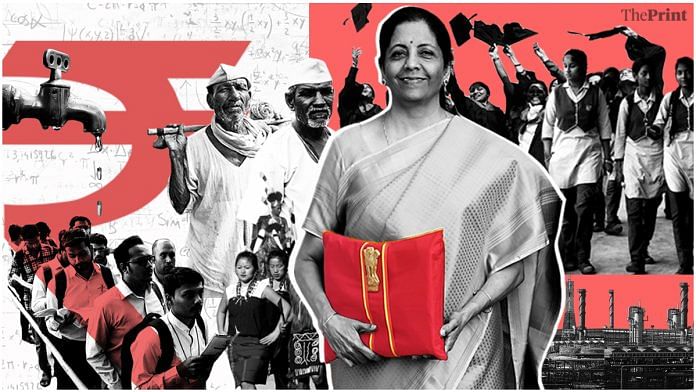The Modi government’s Budget 2020 comes in the backdrop of debilitating economic slowdown. Finance Minister Nirmala Sitharaman was expected to announce big bang reforms to reinvigorate the growth cycle. The abolishment of dividend distribution tax, push towards deepening the bond market are some. But she was expected to present a fiscally expansionary budget, with more spending on infrastructure and bigger tax relief.
ThePrint asks: Has Nirmala Sitharaman delivered on high Budget expectations or did slowdown leave no room?
Budget 2020 has a gameplan to boost demand, focuses on development in a structured manner
 Sanjaya Baru
Sanjaya Baru
Distinguished fellow, Institute for Defence Studies and Analyses, New Delhi
Finance Minister (FM) Nirmala Sitharaman has delivered on the expectations surrounding fiscal deficit by pegging it at 3.8% which is in contingency with the FRBM Act. As an FM, she has fulfilled her dharma on that front. However, whether the economy will grow at 6-6.5 per cent depends on whether she has injected enough confidence into investors and consumers. I think the general level of optimism in this regard has dropped due to negative politics in the recent past. It has damaged the credibility of policymaking by the central government.
I think the FM has opted for incremental changes like the new tax slabs, that will address the demand problem, but then again these have been proposed due to constraints of the slowdown.
I believe this was a more practical budget than the interim budget announced last year in July which was a waste of time. Sitharaman’s second budget has a better framework, has focused on development in a structured manner and there is a gameplan on boosting demand. It is certainly a budget that did a lot more homework than the interim budget in July.
Instead of assurance from Budget, hoi polloi is left wondering what the next phase of slowdown will be
 Shankkar Aiyar
Shankkar Aiyar
Visiting Senior Fellow, IDFC Institute
You could call the Budget a missed opportunity at best. Budgets can deliver a message on what the government is doing for a particular segment of society or the voting class for electoral dividends. And/or Budgets can propel momentum for growth by catalysing animal spirits of the economy. Nirmala Sitharaman’s 160-minute Budget speech falls short on both counts.
When the economy has been sliding for six quarters, when rating agencies are worried about the state of public finances, when the young are agitated about job opportunities, the least that is expected is the articulation of assurance that the future will be better.
The Budget struggles to present what it stands for or what it aims to achieve. The long preamble about a vision for the future was cloudy and confused. The ideas for agriculture, infrastructure and human development depend on capacity of the states to deliver. They rest not on allocations, but on pious evangelism that the states will do what is necessary.
The few sparks in the speech, the decision to list LIC, which is bold, the reversal of tax on dividends from companies to individuals, reflect what could have been. Instead, the hoi polloi is left wondering what the next phase of the slowdown will be.
FM Sitharaman tried to match expectations of Budget, but her assumptions weren’t based on credible numbers
 Arvind Mayaram
Arvind Mayaram
Former finance secretary
I believe Finance Minister Nirmala Sitharaman tried to match the expectations of the Budget, but I do not believe the assumptions made were based on credible numbers.
First, the tax revenues have not been growing in the manner estimated by the central government. Second, as former finance secretary Subhash Garg had said, the actual fiscal deficit will be over 4 per cent of the GDP, which is much higher than what is being acknowledged. As far as the IT exemptions in personal tax slabs are concerned, we must note that these will only benefit less than 8 per cent of the population who are IT taxpayers. If 92 per cent are not benefitted, how do you create a virtuous cycle of consumption, investment, jobs and higher wages? I wish the finance minister had stated up front that gross investment as a percentage of GDP has fallen to around 28 per cent, consumption has collapsed, jobs have been lost instead and real wages are falling. And then stated how the Budget would address each one of these.
There are two sectors that needed special focus. First, the automobile sector, which is one of the largest employers in the organised sector, is still reeling from the slowdown. The other is the real estate sector, which has been in a slump. The construction sector provides earnings for rural labour during the off season. There is some focus on affordable housing, a very narrow subset of the construction industry.
Budget 2020 is a bold, far-sighted one that Nirmala Sitharaman will get little credit for
 Sarthak Agrawal
Sarthak Agrawal
Economist, Institute for Fiscal Studies, London
The Budget 2020 wasn’t an ordinary one but was an intellectual slugfest between the greatest economists of the 18th and the 20th centuries. While the Economic Survey invoked Adam Smith’s ‘invisible hand’ of the free market, many economists (armchair and otherwise) expected a Keynesian demand stimulus.
Three facts show how Smith has convincingly triumphed over his contemporary in this Budget. Finance Minister Nirmala Sitharaman demonstrated exemplary courage in lowering the fiscal deficit by 0.3 per cent of the GDP during the economic slowdown. Clearly, she believes that fiscal prudence and the combination of corporate tax cuts, privatisations and bank mergers will bring returns without having to spook bond markets.
Second, the cuts in personal income tax are too small to be evidence of any countercyclical fiscal policy. North Block expects to forego only Rs 40,000 crore annually from this measure while 2019’s corporate tax cuts cost Rs 1.45 lakh crore — more than three-and-a half-times bigger and set to rise further.
Finally, education, which yields long-term returns, has seen a steep increase in outlay unlike MGNREGA that barely found mention in the Budget speech. This is a bold, far-sighted Budget that unfortunately Sitharaman will get too little credit for. She has defied expectations and stuck to her convictions not because of the slowdown but despite it.
Modi’s govt’s Budget lacks the aim and focus on bringing the economy out of crisis
 Aashita Dawer
Aashita Dawer
Associate Professor (Economics), Jindal Global Law School, O.P. Jindal Global University
The expectation from today’s budget was that the finance minister will focus on reviving the economy. She made some big announcements, but all seem to be in vain. The big highlight in today’s budget is the cut in corporate tax rates as in income tax rates. However, when the economy is going through a slowdown, as is ours, cutting of these rates does not necessarily mandate higher investment or spending as it may increase savings. Instead, it would have been better if the money could have been directly given to the deprived section under MNREGA or other schemes, which would have definitely increased spending.
Further, the fiscal deficit target has been revised only by 0.5 per cent i.e. from 3.3 per cent to 3.8 per cent which will result in only a marginal increase in government spending and would not be able to push the economy to grow at the targeted of 7 per cent. Additionally, the finance minister has pegged the Nominal GDP growth rate to 10 per cent. Even if we have a low inflation rate of 4.5 per cent, which amounts to a real GDP growth rate of only 5.5 per cent, we remain much below the projected target of 7 per cent.
Privatization of Railways, liberalization of agriculture, consolidation of banks and selling a part of government stake in LIC seem to be desperate attempts towards making the fiscal accounts prudent.
Wasteful expenditures such as making five new archaeological sites and a task force on recommending women’s marriageable age must have been avoided.
Thus, the Budget seems to lack the aim and focus on bringing the economy out of crisis.
Budget 2020 lacks any ‘big idea’ or clear strategy to battle the slowdown
 Kriti Upadhyaya
Kriti Upadhyaya
Research Associate, Wadhwani Chair in US-India Policy Studies
Finance minister (FM) Nirmala Sitharaman delivered one of the longest budget speeches, but missed expectations as she lacked any “big idea” or clear strategy to battle the slowdown. Despite Friday’s economic survey advocating privatization, and the government’s own widening of fiscal deficit and missed divestments targets for 2019-20, there was no major push for aggressive divestments in the Budget.
Perhaps, the budget’s biggest gift is for the markets. The announcement to abolish the Dividend Distribution Tax will boost investor confidence. Although the FM met this expectation, she fell short of reducing the long-term capital gains tax. Notwithstanding the economic slowdown, foreign investors have been bullish on India, as evident from foreign direct investment (FDI) inflows. Hence, measures to boost foreign investment will provide relief as well. These include increasing the Foreign Portfolio Investment (FPI) limit in corporate bonds from 9 per cent to 15 per cent. The finance minister also announced new legislation on the enforcement of contracts and the creation of an investment clearance cell. However, protectionist measures accompanied in the Budget can cast a shadow on these positive moves and reflect government’s own fear of slowdown.
Announcements like the review of the Customs Act, review and withdrawal of customs exemptions by September 2020, and customs duties on footwear and furniture could hint at more protectionisms ahead.
Also read: Focus on rural India, women, SC/STs — Budget 2020 fits into Modi govt’s welfare plank
By Pia Krishnankutty, journalist at ThePrint.




It is a second poor budget in succession. There is not even a mention of economic slowdown and persisting economic challenges in the lengthy speech delivered by the FM. It is just presented as a routine budget in an ordinary situation. Most disappointing.
Listing of LIC needs to be viewed with circumspection. Like ONGC, it has been bled of vitality. Unlike ONGC, all its surplus funds do not represent accumulated profits. Advance receipts by way of premia. It is being directed to participate in the disinvestment process, with the long term interests of its policy holders subordinated to fiscal imperatives. Not being permitted to take dispassionate, business like decisions while investing its funds. 2. One would venture to suggest that standards of corporate governance followed by the government do not conform to what SEBI would enforce in the private sector. The government is often unfair to minority shareholders. So, instead of selling small stakes to the public and retaining majority ownership and absolute managerial control, it would be more appropriate to either retain 100% ownership, or offer all of it for sale, as is being considered for Air India.
It would be ungenerous to regard the market’s near 1,000 point fall as an accurate, infallible assessment of the Budget. 2. Two features of the economy, the collapse of growth and huge fiscal stress, reinforcing each other – here it would not be ungenerous to hold the government largely responsible for both – ought to have been addressed by the government as its central focus for the second term. Clearly there was no room for fiscal giveaways or enlarged government spending. 3. So the government ought to have focused on genuine reform, in sectors as basic as banking and power. What we have got by infusing 3.5 trillion as “ recap “ funds for the PSBs, with credit growth at historic lows. There is no Thatcherite vision behind disinvestment – no way it can yield two trillion – beyond a desperate need to sell the family silver to pay the grocery bills. 4. 2024, when a third term will be solicited, would mark a decade in office. Whatever else it may have achieved, a decently performing economy is not looking like being part of the legacy.